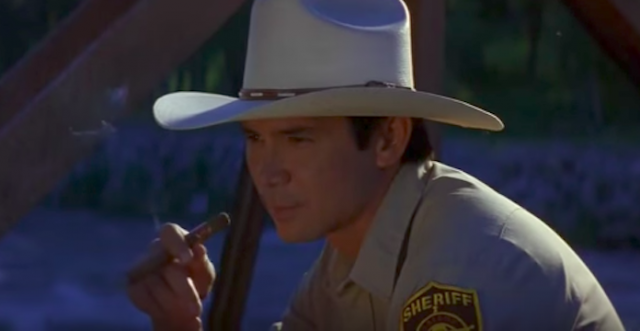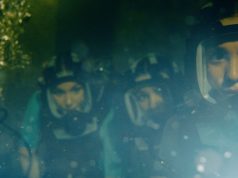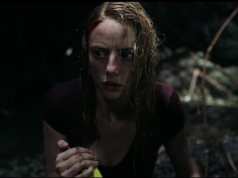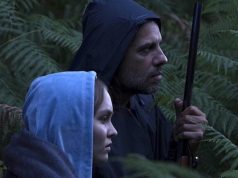
A lot of people find bats creepy, not just because they turn into Draculas, but also because they are basically rats that learned how to fly. So it’s surprising that bats have been the subject of so few entries in the genre of Movies Where Swarms of Animals Attack People. You’d think filmmakers would go there before they resorted to killer rabbits, killer frogs, or killer laundry machines.
There is “Bats,” though. It came out in 1999 — and the fact that “Bats” was not already the title of a dozen other movies by 1999 shows you just how anti-bat Hollywood was. With its cheesy special effects and vaguely famous cast, “Bats” is the sort of movie you’d expect to see premiere on the SyFy Channel, accompanied by lots of movie-hipster hype about how “awesome” (i.e., terrible) it is. That’s a good place for movies like this, because everyone gets the SyFy Channel anyway and there’s no commitment to watch the entire movie. Yet for some reason Bats played in cinemas, where you could only see it if you gave money to the people who operated the theater. Not many people did this, but still, the fact that it was even an option.
“Bats” is an unapologetic rip-off of “The Birds,” “Jaws,” “Jurassic Park,” “Gremlins,” and all the other nature-runs-amok movies. It adheres so closely to the standard formula that one is tempted to believe it emerged fully formed from Roger Corman’s toilet bowl. (“Huh!” Corman might have said. “Must’ve had too much Spielberg last night!”)
We begin in the usual fashion, with a pair of randy teenagers being killed while they sit in a parked car late at night. They are attacked by something — it’s hard to tell what, exactly, because whatever it is also makes the camera whip around wildly, but we’re pretty sure it’s bats. This is in rural Texas, where nature and man have been battling one another for centuries, with most of the victories so far going to nature.
Then we hop over to nearby Arizona, where Dr. Sheila Casper (Dina Meyer), the world’s foremost bat scientist and adventurer, is clambering around in some caves, spying on bats and writing down all the cute things they do for her diary, or whatever. She is assisted by a fellow named Jimmy (Leon Robinson). Now, I’m going to tell you that Jimmy is black. Knowing this, and having seen a few of these movies in your day, can you guess what Jimmy is like? If you guessed that he cracks jokes and hates bats and is afraid of everything and generally behaves like a comical coward, you are correct!
Sheila and Jimmy are interrupted by the arrival of a helicopter carrying Dr. Hodge (Carlos Jacott), a Centers for Disease Control official who has come to get Sheila’s help on an important bat-related matter. The CDC may have a crisis on its hands, and Sheila is the only one who can help, and they need her NOW!! Hence the chopper ride out to the middle of the desert. What, the government can’t call first? They always just show up at the research site or the archeological dig or wherever the important scientist is and drag him or her away. What if Sheila can’t go right now? What if Sheila has other plans this afternoon? What if she has a doctor’s appointment, and if she doesn’t show up she’ll still be charged? Is the government going to pay for that?
My lifelong dream is to have my workday disrupted when a government helicopter lands outside and out pops a suit-wearing bureaucrat telling me that my country needs me.
Sheila and Jimmy join Dr. Hodge and head to the small town of Gallup, Texas, where those teenagers got ripped apart. (I don’t think the CDC really needs Jimmy, but I guess he wouldn’t have had a ride back if he didn’t hop on the helicopter when Sheila did.) A wormy scientist named McCabe (Bob Gunton) fills everybody in on the details, which are basically that he tampered in God’s domain and now nature is going to kill everybody. Seems McCabe imported a couple of large bats from Indonesia so he could do some experimentin’, then infected them with a virus that makes them smarter, aggressive, and carnivorous, and then lost them. Scientists are good at making things more dangerous, not as good at remembering where they put them. Sheila asks McCabe the obvious question, i.e., why he would intentionally make bats smarter, aggressive, and carnivorous. McCabe’s answer: “Because I’m a scientist! That’s what we do! We make things better!” It’s eventually revealed that there’s slightly more to it than that — the government wanted to turn the bats into weapons, or something — but McCabe’s answer is good enough for me.
Now these new and improved bats have apparently infected the local bat population with McCabe’s virus, and that’s why the teens got slaughtered and why there have been reports of mysteriously mangled livestock. If a person is bitten by one of these infected bats, will that person also become smarter, aggressive, and carnivorous? Because that sounds like a pretty rad horror movie. But, no, thank goodness, the virus can only be transmitted from bat to bat, and since bats are fairly easy to avoid — don’t go outside at night where there are bats — the movie is in no danger of becoming truly exciting.
Sheila’s duty is clear: She must find a way to cure or kill every bat in west Texas. She doesn’t want to be forced into committing mass baticide, though.
“The thought of killing one goes against everything I’ve come to believe,” she says.
Everything she’s come to believe? Her entire life’s philosophy can be summed up by “Don’t kill bats”? That is an unusually specific religious dogma.
Assisting her is Gallup’s town sheriff, Emmett (Lou Diamond Phillips), who loves his town and will not sit idly by while its inhabitants are murdered by flying rodents. McCabe and the CDC guy will help too, though it’s pretty clear that McCabe is loyal to bats over humans and cannot be trusted. Just as clear: McCabe will eventually die from bat-related causes, yet will be very surprised when it happens.
Sheila and Emmett soon discover that there are thousands upon thousands of bats in the caves nearby, all of them angry, belligerent, and hungry for meat — like a stadium full of Cowboys fans, only smarter. Jimmy does his “Aw, hell no!” and “Feets don’t fail me now!” routines. Emmett and the mayor try to evacuate Gallup, but everyone ignores the warnings and strolls through the town square at dusk as if it were an ordinary summer evening. “People in Texas think they know everything about everything!” the mayor says by way of explanation. Those maverick Texans, always disregarding evacuation orders when slaughter is imminent! You’ll recall the same thing happened at the Alamo.
As predicted, many Gallup residents perish when the bats descend on the town and bite lots of them to death. That’s all they’re doing, too, by the way, is biting people. Despite the claims that these bats are bloodthirsty carnivores, they aren’t completely devouring anybody, or even nibbling anybody beyond recognition. You’ll see a dead victim and think, Why, 90 percent of the meat is still on his body! The bats hardly touched him! For a species that has only recently converted to flesh-eating, they’re being awfully wasteful.
Once daylight comes and the bats go to sleep like the lazy bastards they are, the U.S. Army rolls into town and reveals that it has a plan. It’s the same plan the military always has in these movies, i.e., blow everything up. Drop some bombs on the cave where the bats live, blow ’em to smithereens. Sheila says the explosion would just make the bats scatter, and that most would escape and simply find a new home. The Army guys say it doesn’t matter if it’s not going to work, they’re going to do it anyway, because it’s the only plan they have. When all you’ve got is a hammer, everything looks like a nail; when all you’ve got is a bunch of bombs, everything looks like a cave full of bats.
But they give Sheila 48 hours to come up with a better plan, “better plan” in this case defined as “plan that does not have a 100 percent chance of failure.” She and Emmett and Jimmy brainstorm. “This is like a nightmare!” Jimmy says. “I’ll never sleep again!” And just like that, Sheila’s got it: “That’s it! We’ll put them to sleep!” The bats, she means, not the Army. Not the way you’d expect, either (bat lullabies), but with cold air. Sheila informs us that bats hibernate if it gets below 40 degrees, and freeze to death if it gets below 32. Basically, if you’re a bat, there’s only 8 degrees’ difference between napping and dying, which is why bats tend to spend most of their time in warm places like caves and people’s hair.
All Sheila and friends have to do is get a huge generator-powered air-conditioner down into the cave while the bats are having their morning siesta, crank that sucker up, and let the creepy things freeze. A huge generator-powered air-conditioner being near at hand thanks to the town’s proximity to the Acme Plot Convenience factory, this plan proves easy to execute; the movie ends, and we get to go home early. No word on whether Sheila feels remorse at how easily she renounced her “Don’t kill bats” religion, but in her defense, that was a pretty restrictive rule.
— Film.com





